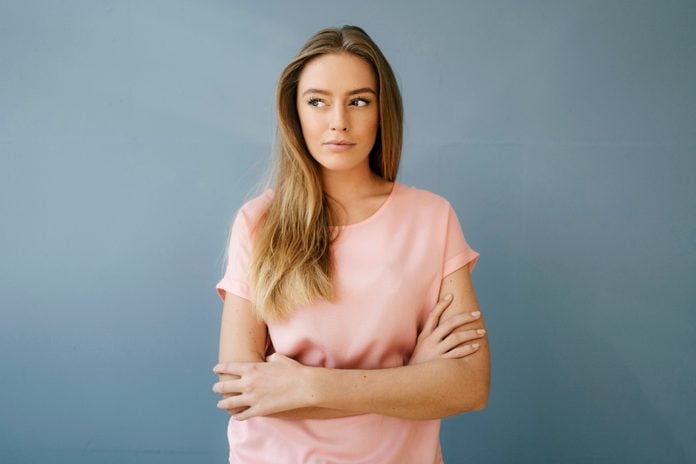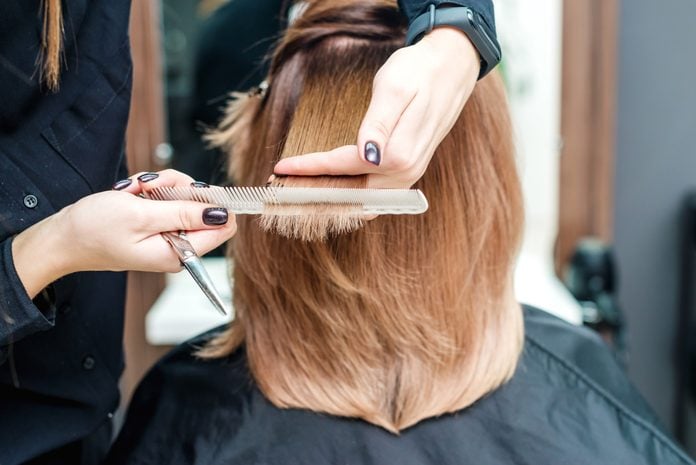
Assuming you can’t pull off layers
You might assume that giving your hair layers will make it look thinner than ever. But in reality, layers can be great for fine hair, says Adam Broderick, owner of Adam Broderick Salon & Spa. “Soft layers can remove some of the weight and let some of the hair be released and have more volume,” he explains. With more movement, your hair will actually look thicker. Looking for a new look? Here are 40 of the best hairstyles for women over 40.
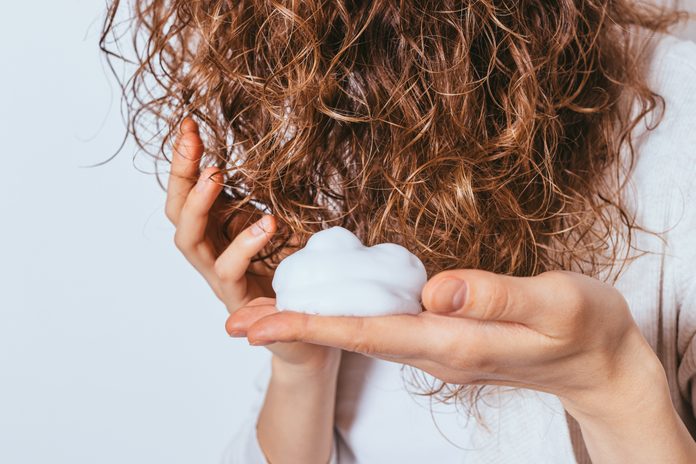
Aiming for a soft and silky texture
For more body and volume, you might have to sacrifice silkiness to get the look you want. Conditioners, oils, and other products aimed to make your tresses softer will make fine hair go limp. “If our hair is [naturally] soft, it can’t feel soft anymore—it has to feel rougher for it to look good,” explains hairstylist Jon Reyman, co-founder of Spoke & Weal Salon. He recommends staying away from any oily and creamy products meant to soften the hair. Instead, stick with grippier products like beach sprays and mousses that will give you lift, even if the texture feels stiff. The right shampoo for thin hair will also help. One to try: Kérastase Densifique Bodifying Shampoo, which fans say improves the integrity of strands and creates hair that’s “so much fuller and bouncier.”
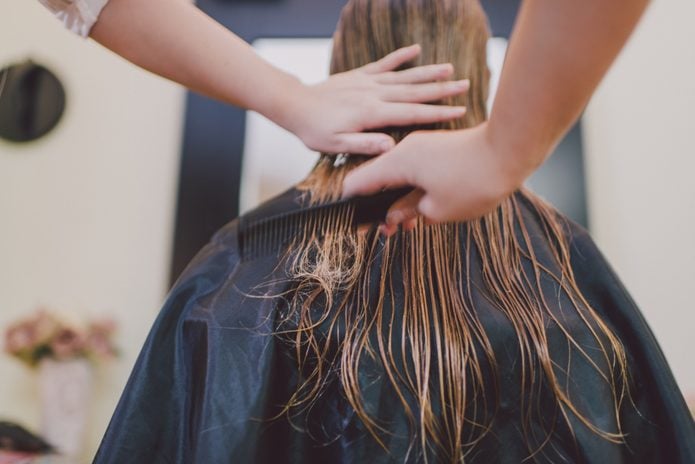
Trying to grow hair too long
Fine hair is more damage-prone than thicker hair. Because your ends are the oldest part of your hair, they’ve already seen their fair share of damage and are even more vulnerable. Unfortunately, that also makes thin hair harder to grow out. “With fine hair, it breaks off so you can’t usually get it really long,” says Reyman. If you don’t have much density, ask your stylist to help figure out the longest your hair can grow while still looking good, says Broderick. You’ll also want to avoid these other hairstyle mistakes that age your face.
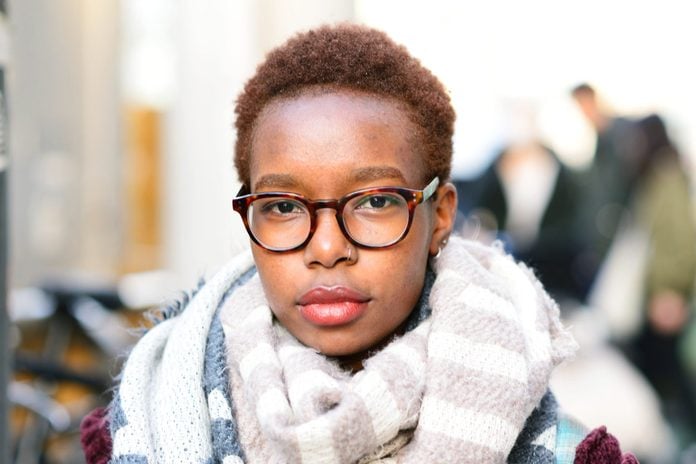
Believing natural hair can never be fine-textured
Black hair is often curly, fragile, and super dry. But don’t assume this hair type is always coarse and thick. Despite the natural texture, some Black hair can actually be fine in structure, and heavy, cloying conditioners and oils might be too overpowering. Not sure where your strands stand? Here are some surefire giveaways that your hair actually has a fine texture: Your set curls don’t hold up very well; you frequently suffer from static or flyaways; and even though you have a mass of curls, your hair still doesn’t look full and thick.
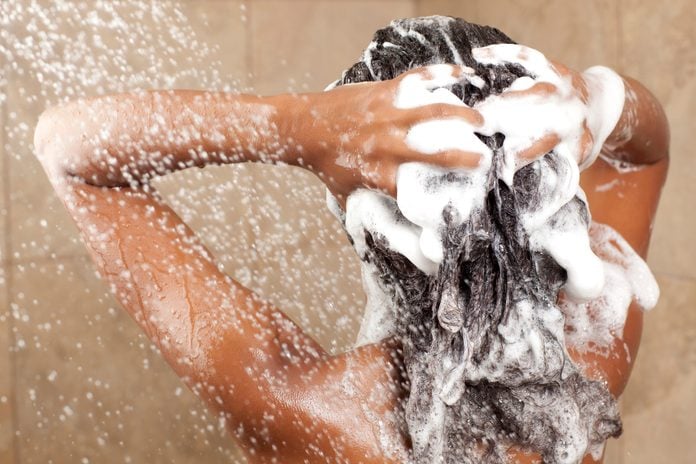
Washing hair too often
“It’s no secret that washing your hair every day will strip natural oils and fade your color faster,” says Love. “But it also teaches your scalp to expect frequent shampoos, which means it will start quickly releasing more oils.” The problem with that? Your oh-so-clean fine hair will become greasy fast and end up limp and droopy. Love recommends “training” your scalp, by not cleansing more than two to three times per week and using a good volume-boosting, oil-absorbing product in between, like Joico’s Weekend Hair Dry Shampoo. Learn the other things you’re doing to your hair that a stylist wouldn’t.
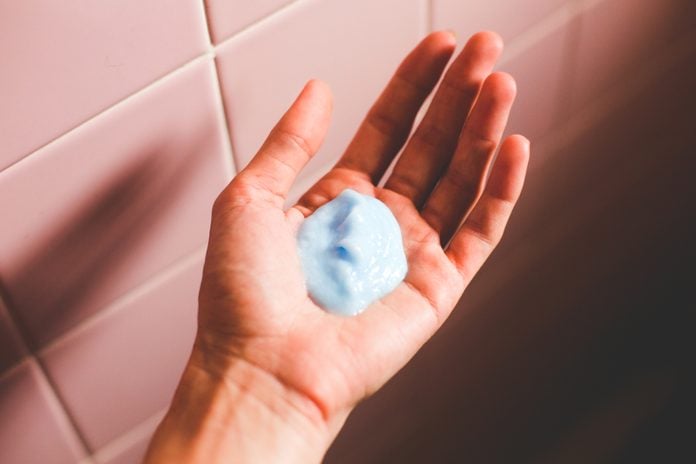
Overdoing the conditioner
Because conditioner gives that smooth (but limp) look and feel, Reyman recommends giving it up entirely. But if skipping conditioner makes your hair way too dry and damaged, use Broderick’s tip and apply a little bit to the ends only. Using too much or getting it toward your scalp will weigh your hair down. “If you’re going to condition, put it on wet hair so the water works as somewhat of a filler,” he says. That means any heavy leave-in conditioners are out. Look for one that says it’s “weightless,” says Broderick. Check out this list of the best conditioners for fine hair—and every other type, as well.
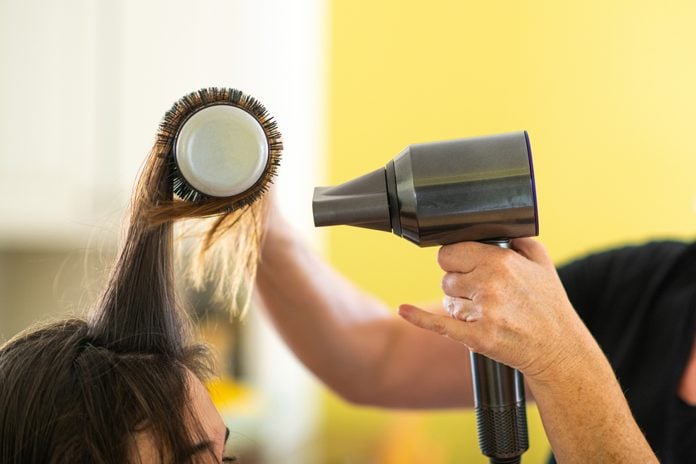
Blow-drying hair straight down
You might be going for straight and shiny in your attempt to avoid frizz, but doing so drags hair down and results in a flat finish. Love adds volume to her own fine hair by applying Joico’s JoiFull Volumizing Styler—a unique cream/gel hybrid formulated especially for fine hair—then starts her blow-dry session using a flat paddle brush placed against the head and drying hair upward, against the natural fall line. Continue this move until hair is about 75 percent dry, then switch to a round brush. (More on that, below.)
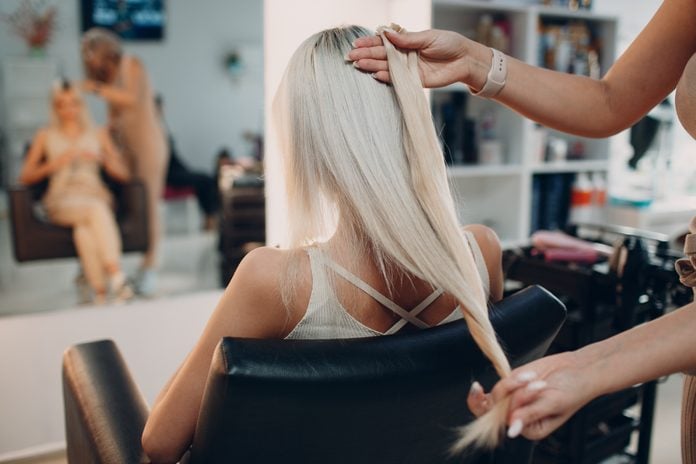
Overusing professional hair extensions
Both tape-in and hand-tied hair extensions have become an extremely sophisticated and popular way to add volume and length to fine hair. But long-term use can result in breakage if you’re not careful. A smart alternative to consider: easy-to-use clip-in hair extensions, which allow you to temporarily amp up your style without the risk of damage.

Not thinking outside the box with your styling tools
Have a crimping iron lying around? Try using it to create a fuller look near your part, suggests celebrity hair and makeup artist Olivia Smalley, Joico’s Global Brand Storyteller. Smalley strategically crimps a section of hair right up close to the part line—but leaves an uncrimped layer of hair over it. “It’s like a veil of non-crimped hair that camouflages the volume,” she explains. Here’s an inexpensive alternative if you don’t own a hot tool: Place a volumizing duck-bill clip on either side of your part; spray the section with water; then blow-dry on low power. When the hair cools, remove the clips, and poof! Instant volume.

Forgetting to protect hair from frizz
Anyone with fine hair who’s walked outside into humidity or moisture-filled air has likely experienced an attack of dreaded frizz. It can happen if your hair is still slightly damp (even after a professional blow-dry session), so always make sure strands—especially the underneath layers—are fully dry. You can double down on frizz protection with a product designed to put a shield between your hair and the elements, like Color Wow Dream Coat Supernatural Spray, which boasts more than 14,000 five-star reviews on Amazon (read ours, too!).
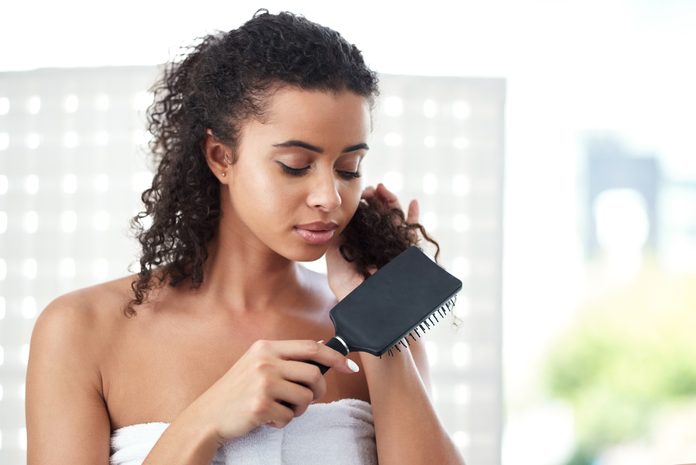
Not using a big enough brush
Turns out, size does matter—especially when it comes to the hairbrush you use for styling and blow-drying your fine hair. “After pre-drying your hair with a paddle brush, use a large, round, metallic brush to add volume and roundness to the hair,” Love advises. “The metallic barrel heats up with your blow-dryer, becoming a styling tool that adds bend and bounce. And the larger the barrel size, the more body you can add to the hair.” Next, find the best hair mask for shiny, voluminous locks.
Sources:
- Larisa Love, a Los Angeles–based hairstylist and Joico Global Brand Ambassador
- Adam Broderick, owner of Adam Broderick Salon & Spa
- Jon Reyman, cofounder of Spoke & Weal Salon
- Olivia Smalley, a celebrity hair and makeup artist and Joico’s Global Brand Storyteller

